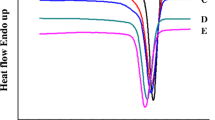Abstract
The moldability and robustness of thermoplastic paramylon mixed esters are highly related to primary structural parameters, such as the length of the long-chain acyl group and its degree of substitution. Short chain lengths and lower substitution degrees provide more robust molded thermoplastics, whereas longer chains and higher substitution degrees improve moldability. Herein, the choice of an appropriate long-chain acyl group (lauroyl or myristoyl) and the effect of the substitution degree were investigated by examining the thermal and mechanical properties of a series of paramylon acetate laurates and myristates and comparing them with those of their curdlan analogues. Melt volume flow rate measurements (180–220 °C) indicate that myristoyl substitution in paramylon results in a local thermoplasticity maximum at a substitution degree of 0.35 at higher temperatures (above ~ 200 °C). These measurements and dynamic viscoelastic analyses suggest that the myristoyl substitution serves an “internal plasticizer” in the higher strain range and higher temperature region (~ 200–230 °C), while it serves as a “viscosity increaser” in the lower strain range and lower temperature region (170–200 °C). Moreover, tensile and bending testing showed that this product exhibits superior mechanical strength. The successful realization of a good balance between moldability and robustness suggests that fine-tuning the chain length and substitution degree is an effective approach for producing thermoplastic polysaccharides with superior injection moldabilities and mechanical robustness.






Similar content being viewed by others
References
Edgar KJ, Buchanan CM, Debenham JS, Rundquist PA, Seiler BD, Shelton MC, Tindall D (2001) Prog Polym Sci 26:1605
Ifuku S, Ikuta A, Egusa M, Kaminaka H, Izawa H, Morimoto M, Saimoto H (2013) Carbohydr Polym 98:1198
Ifuku S, Saimoto H (2012) Nanoscale 4:3308
Isogai A, Saito T, Fukuzumi H (2011) Nanoscale 3:71
Iwatake A, Nogi M, Yano H (2008) Compos Sci Technol 68:2103
Puanglek S, Kimura S, Iwata T (2017) Carbohydr Polym 169:245
Savage AB, Young AE, Maasberg AT (1954) In: Ott E, Spurlin HM, Grafflin MW (eds), High polymers, vol V. Interscience Publishers Inc, New York
Teramoto Y, Yoshioka M, Shiraishi N, Nishio Y (2002) J Appl Polym Sci 84:2621
Erdmann R, Kabasci S, Kurek J, Zepnik S (2014) Materials 7:7752
Zepnik S, Kabasci S, Kopitzky R, Radusch H-J, Wodke T (2013) Polymers 5:873
Malm CJ, Kaul OW, Hiatt GD (1951) Ind Eng Chem 43:1094
Park H-M, Misra M, Drzal LT, Mohanty AK (2004) Biomacromol 5:2281
Toyama K, Soyama M, Tanaka S, Iji M (2015) Cellulose 22:1625
Iji M, Toyama K, Tanaka S (2013) Cellulose 20:559
Peydecastaing J, Vaca-Garcia C, Borredon E (2011) Cellulose 18:101
Shibakami M, Tsubouchi G, Sohma M, Hayashi M (2015) Carbohydr Polym 133:421
Shibakami M, Sohma M (2017) Carbohydr Polym 155:416
Shibakami M, Tsubouchi G, Hayashi M (2014) Carbohydr Polym 105:90
Shibakami M, Tsubouchi G, Sohma M, Hayashi M (2015) Carbohydr Polym 119:1
Shibakami M (2017) Carbohydr Polym 173:451
Tamura N, Wada M, Isogai A (2009) Carbohydr Polym 77:300
Okuyama K, Obata Y, Noguchi K, Kusaba T, Ito Y, Ohno S (1996) Biopolymers 38:557
Marubayashi H, Yukinaka K, Enomoto-Rogers Y, Takemura A, Iwata T (2014) Carbohydr Polym 103:427
Zhai W, Danjo T, Iwata T (2017) J Polym Res 25:181
Zhai W, Iwata T (2019) Polym Degrad Stab 161:50
Shibakami M, Sohma M (2018) Carbohydr Polym 200:239
Buchanan CM, Buchanan NL, Debenham JS, Gatenholm P, Jacobsson M, Shelton MC, Watterson TL, Wood MD (2003) Carbohydr Polym 52:345
Yang BY, Montgomery R (2008) Starch 60:146
Buchanan CM, Parker SW (1991) Patent WO9114709
Tezuka Y (1993) Carbohydr Res 241:285
Tezuka Y, Imai K, Oshima M, Ito K-I (1991) Carbohydr Res 222:255
Tezuka Y, Tsuchiya Y (1995) Carbohydr Res 273:83
Crépy L, Miri V, Joly N, Martin P, Lefebvre J-M (2011) Carbohydr Polym 83:1812
Acknowledgments
The authors are grateful to KOBELCO Eco-Solutions Co. Ltd. for providing the paramylon samples used in this work. The authors are also grateful to Dr. Yuki Kawata (TA Instruments Japan Inc.) for her technical assistance with the dynamic viscoelastic analyses. This research did not receive any specific Grant from funding agencies in the public, commercial, or not-for-profit sectors.
Author information
Authors and Affiliations
Contributions
All authors contributed to the study conception and design. Material preparation, data collection and analysis except for XRD were performed by Shibakami. XRD was performed by Shibakami and Sohma. The first draft of the manuscript was written by Shibakami. All authors read and approved the final manuscript.
Corresponding author
Ethics declarations
Conflict of interest
The authors declare that they have no conflict of interest.
Additional information
Publisher's Note
Springer Nature remains neutral with regard to jurisdictional claims in published maps and institutional affiliations.
Electronic supplementary material
Below is the link to the electronic supplementary material.
Rights and permissions
About this article
Cite this article
Shibakami, M., Sohma, M. Effects of Long-Chain Acyl Substituents on the Thermoplasticity and Mechanical Properties of Paramylon Mixed Esters. J Polym Environ 28, 2263–2276 (2020). https://doi.org/10.1007/s10924-020-01763-2
Published:
Issue Date:
DOI: https://doi.org/10.1007/s10924-020-01763-2




